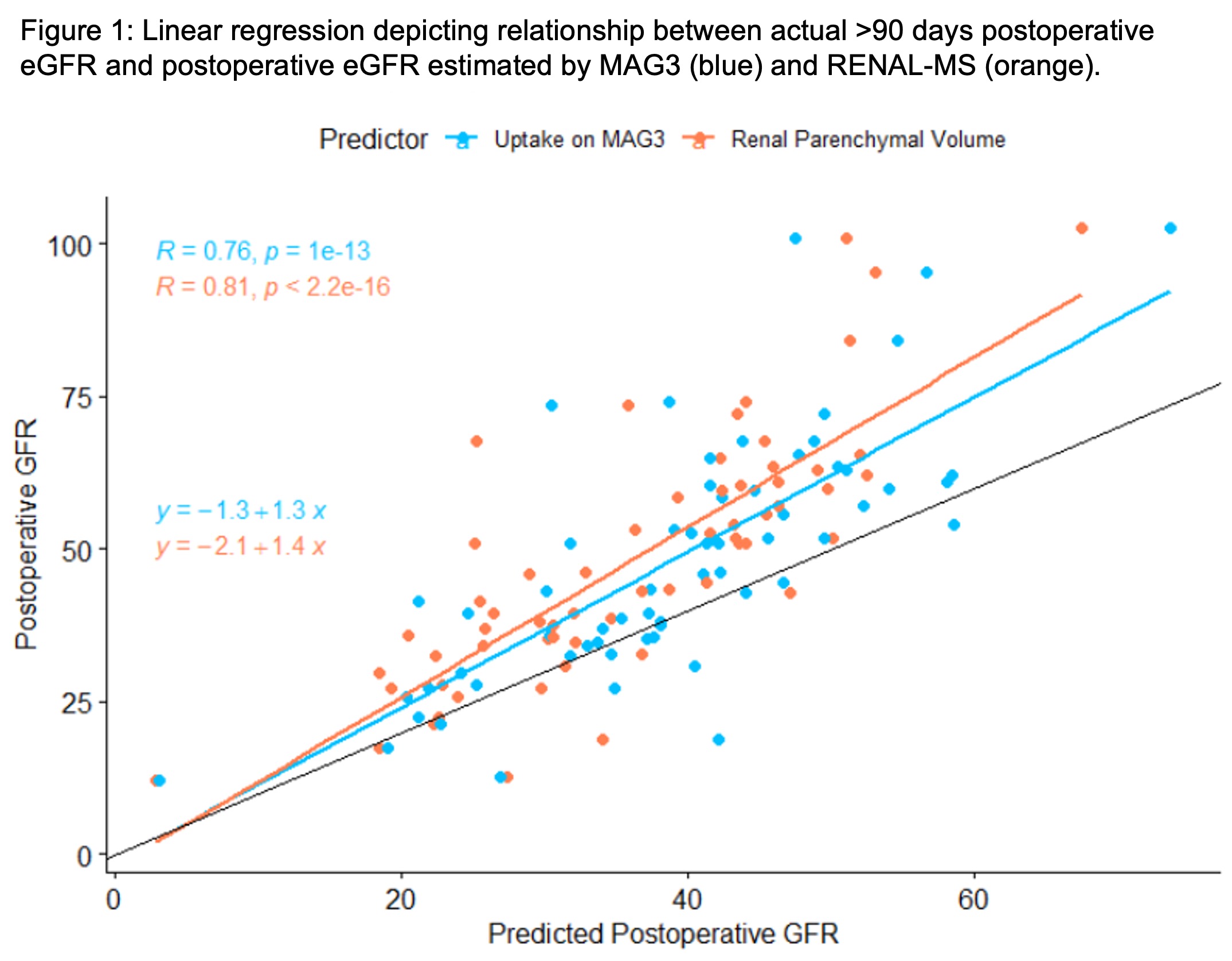Back
Poster, Podium & Video Sessions
Moderated Poster
MP24: Kidney Cancer: Localized: Surgical Therapy I
MP24-08: Real-time Estimation of Nephron Activity with a Linear Measurement System (RENAL-MS) Obviates the Need for Nuclear Medicine Scans to Predict Glomerular Filtration Rate After Nephrectomy
Saturday, May 14, 2022
8:45 AM – 10:00 AM
Location: Room 222
Jared Schober*, Matthew Loecher, David Strauss, Eric Cho, Alberto Castro Bigalli, Kevin Ginsburg, Alexander Kutikov, Philadelphia, PA, Marshall Strother, Portland , OR

Jared Schober, MD
Urologic Oncologist, Assistant Professor
Poster Presenter(s)
Introduction: Nuclear medicine renal scintigraphy (NMRS) is often used to predict glomerular filtration (eGFR) after nephrectomy. Recent data have shown that measurements of renal parenchymal volume using specialized software can be used to predict postoperative eGFR accurately, obviating the need for NMRS. We sought to determine whether a simplified measurement system using tools available in the basic image display software could be used to replace NMRS in current clinical practice.
Methods: We performed a retrospective review of institutional patients who underwent abdominal cross-sectional imaging (CT or MRI) and Mercaptoacetyltriglycine (MAG-3) renal scintigraphy prior to total nephrectomy. Patients with hydronephrosis, active or chronic infection, and missing creatinine were excluded. A formula incorporating renal length and the mean of 6 renal parenchymal thickness measurements was utilized to estimate differential kidney function and predict postoperative eGFR through a clinical point-of-care Real-time Estimation of Nephron Activity with a Linear Measurement System (RENAL-MS). The predictive ability of RENAL-MS for estimation of postoperative eGFR was compared to MAG-3 scintigraphy using linear regression.
Results: 66 patients met study criteria with a median age of 69 (IQR 61-80) years. The most common indications for nephrectomy were renal cell carcinoma (55%) and upper tract urothelial cancer (24%). Median solid renal tumor diameter was 5.0 (3.65-6.50) cm. Median preoperative and postoperative eGFR was 72 (53-87) mL/min/1.73^2 and 46 (35-62), respectively. Correlation between actual =90 day postoperative eGFR and predicted postoperative eGFR using RENAL-MS and MAG3 were nearly identical, with RENAL-MS being numerically superior (R = 0.81 and 0.76; p<0.001 and <0.001, respectively). (Figure 1)
Conclusions: Simple linear measurements of renal volume are equally accurate to split renal function measured on NMRS for prediction of eGFR after nephrectomy in our population. The use of NMRS in this clinical context may be safely abandoned for these patients.
Source of Funding: None

Methods: We performed a retrospective review of institutional patients who underwent abdominal cross-sectional imaging (CT or MRI) and Mercaptoacetyltriglycine (MAG-3) renal scintigraphy prior to total nephrectomy. Patients with hydronephrosis, active or chronic infection, and missing creatinine were excluded. A formula incorporating renal length and the mean of 6 renal parenchymal thickness measurements was utilized to estimate differential kidney function and predict postoperative eGFR through a clinical point-of-care Real-time Estimation of Nephron Activity with a Linear Measurement System (RENAL-MS). The predictive ability of RENAL-MS for estimation of postoperative eGFR was compared to MAG-3 scintigraphy using linear regression.
Results: 66 patients met study criteria with a median age of 69 (IQR 61-80) years. The most common indications for nephrectomy were renal cell carcinoma (55%) and upper tract urothelial cancer (24%). Median solid renal tumor diameter was 5.0 (3.65-6.50) cm. Median preoperative and postoperative eGFR was 72 (53-87) mL/min/1.73^2 and 46 (35-62), respectively. Correlation between actual =90 day postoperative eGFR and predicted postoperative eGFR using RENAL-MS and MAG3 were nearly identical, with RENAL-MS being numerically superior (R = 0.81 and 0.76; p<0.001 and <0.001, respectively). (Figure 1)
Conclusions: Simple linear measurements of renal volume are equally accurate to split renal function measured on NMRS for prediction of eGFR after nephrectomy in our population. The use of NMRS in this clinical context may be safely abandoned for these patients.
Source of Funding: None


.jpg)
.jpg)